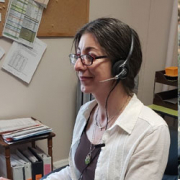Need for Energy Assistance Programs During a Pandemic
By Victorian Tilley, Energy Programs Assistant
The COVID-19 pandemic has had deep impacts upon Americans. Mandatory closures and physical distancing put many people out of work and required them to stay home. The bills do not stop coming in though. And in the case of energy bills, staying home means using more energy, which results in higher bills. Because many Americans were furloughed or terminated from their jobs, paying those bills became a challenge, if not impossible. In some areas, threats of shutoffs were looming over many families, as well. This created an urgent need for assistance.
Two important sources of such assistance stood ready to help: the Low-Income Home Energy Assistance Program (LIHEAP) and the National Energy Assistance Referral (NEAR) service, which connects people to their local LIHEAP office. The program experienced a massive influx of assistance requests since the pandemic began.
In April, NEAR received a total of 173,829 assistance requests, a 72.4% increase over the same month in 2019. The LIHEAP Clearinghouse website saw an astounding 651.9% increase in site users from April of 2019 and another 458% increase from May of 2019.
LIHEAP is a federal program that offers energy assistance to households in every state and in most tribal reservations and territories by assisting households with heating and cooling needs. Those in need of assistance may dial the NEAR hotline and receive information on their state’s available programs. The LIHEAP Clearinghouse website also serves as a network of information and resources on low-income energy issues and delivers this information to grantees, which are the state-specific programs that operate under the block grant, subgrantees like local government and community action agencies, and energy service organizations.
NCAT has operated the LIHEAP Clearinghouse and NEAR for some 30 years, assisting 703,241 households and providing referrals to over 1.2 million visitors of the NEAR directory. The common annual trend is that directory contact volume usually increases in the peak seasons, since some need heating assistance in cold climates and others need cooling assistance in warm climates. Since transition between seasons brings milder weather and subsequent reduction in energy bill costs, the first week of April is typically when calls begin to decrease. This year, the program experienced something quite different.
Specialists at NCAT are responsible for taking calls from the NEAR hotline and referring households from all over the country to their respective state programs. One of our specialists reports that many of the calls right now are coming from residents in the southern states, potentially in response to increased cooling needs, but can also be related to socioeconomic factors. Researchers have monitored trends between low-income households and high energy burden, stating that “[e]nergy burden for low-income households is not declining, and it remains persistently high, particularly in the South, in rural America, among minority households, and those with children and elderly residents” (Brown, et al., 2020). Currently, those seeking assistance are seeking relief for accounts currently in arrears and at risk for shut-off, as many still owe on bills from before the extended utility relief provided under the Corona Virus Aid, Relief, and Economic Security Act (CARES) Act.
Under the CARES Act, put in place to address the economic emergency the pandemic brought on, LIHEAP was provided with $900 million in additional funding that will extend the assistance season through August 2020. States now have more resources and a broader scope of how they can assist people. Those seeking assistance can do so quicker and easier than in previous years that had not seen a pandemic. Additionally, utility companies have put moratoriums on disconnections in place, so that a household’s utilities will not be shut off for overdue bills. However, even though their service cannot be shut off, the residents’ accounts are still accruing charges. When the moratoriums eventually end, the program predicts another spike in calls once households are hit with cumulative bills for all their heating or cooling usage.
Visit the LIHEAP Clearinghouse website to learn more about its focus and goals. LIHEAP’s programming operates on a state-by-state basis in order to be specific and uniquely responsive to the needs in each state. Visit the state snapshots to learn more about specific programming. Additionally, you can view the research on trends of low-income energy affordability and opportunities for future policy and programming.
Reference:
Brown, Marilyn Ann, Anmol Soni, Melissa Voss Lapsa, and Katie Southworth. 2020. Low-Income Energy Affordability: Conclusions From A Literature Review. Oak Ridge National Laboratory. Report No. ORNL/TM-2019/1150. March 31. https://www.osti.gov/servlets/purl/1607178.



